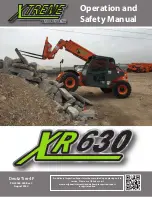
Hydraulic Gear Pump Repair
1900 SRM 97
DISASSEMBLE
NOTE:
See Figure 6, Figure 7, Figure 8, or Figure 9
for the illustration that is similar to the pump being
repaired. The illustration can have parts that are
different than those in the actual pump that is being
repaired.
1.
Remove gear or sprocket from input shaft.
If
equipped, remove pulley from input shaft. See
Figure 5.
NOTE: NOT ALL LIFT TRUCK MODELS HAVE A PUL-
LEY ASSEMBLY ON THE GEAR PUMP.
1.
PLATE
2.
CAPSCREW
3.
WASHER
4.
LOCKWASHER
5.
PULLEY
6.
NUT
Figure 5. Pulley Assembly on Gear Pumps
2.
Before disassembling the pump, make alignment
marks on all housings. Some housings can be as-
sembled in the wrong positions, which will cause
failure or increased wear. Carefully clean the
outside of the pump.
NOTE:
The inlet ports in most gear pumps are larger
than the outlet ports.
NOTE:
If the pump is held in a vise for disassembly,
make sure the vise does not hold the pump too tightly
and cause distortion of the pump body.
NOTE:
The position of the seals is important. In some
pumps the direction of pump rotation is changed by
changing the position of the seals and housings. The
holes in the seals must be aligned with the oil pas-
sages in the housing sections. The oil passage for the
thrust plates is in the outlet chamber.
Make sure you make careful notes of the location and
orientation of the parts and seals during disassem-
bly. Some of the parts are similar, but not exactly
the same and it can be difficult to make an identifi-
cation if they are mixed.
3.
Remove capscrews or nuts that hold housings to-
gether. Use a plastic hammer to separate hous-
ings. Do not damage machined surfaces.
4.
Remove gears and thrust plates (if used). Make
a note of the positions of the thrust plates, seals,
and gaskets. Do not use a punch to mark the
parts. Remove any springs and check valves.
5.
Remove bearings with a puller. In some pumps,
the bearing blocks or plates must be replaced
with the bearings.
6.
Remove front seal.
CLEAN
WARNING
Cleaning solvents can be flammable and toxic
and can cause skin irritation.
When using
cleaning solvents, always follow the solvent
manufacturer’s recommended safety precau-
tions.
WARNING
Compressed air can move particles so they
cause injury to the user or to other personnel.
Make sure the path of the compressed air is
away from all personnel. Wear protective gog-
gles or a face shield to prevent injury to the
eyes.
CAUTION
Any dirt that enters the hydraulic system can
cause damage to the parts.
Clean all parts of the pump with solvent. Use com-
pressed air to dry the parts. Do not use a cloth to dry
the parts. Pieces of the cloth can cause restrictions in
the hydraulic system. Make sure the work area and
tools are very clean.
4
Содержание D174
Страница 1: ...Hyster D174 R30XMS2 Forklift...
Страница 6: ...THE QUALITY KEEPERS HYSTER APPROVED PARTS...
Страница 23: ......
Страница 24: ...TECHNICAL PUBLICATIONS 1900 SRM 97 10 03 7 03 10 02 11 01 4 97 9 93 3 88 11 82 9 81 2 79 Printed in U S A...

























